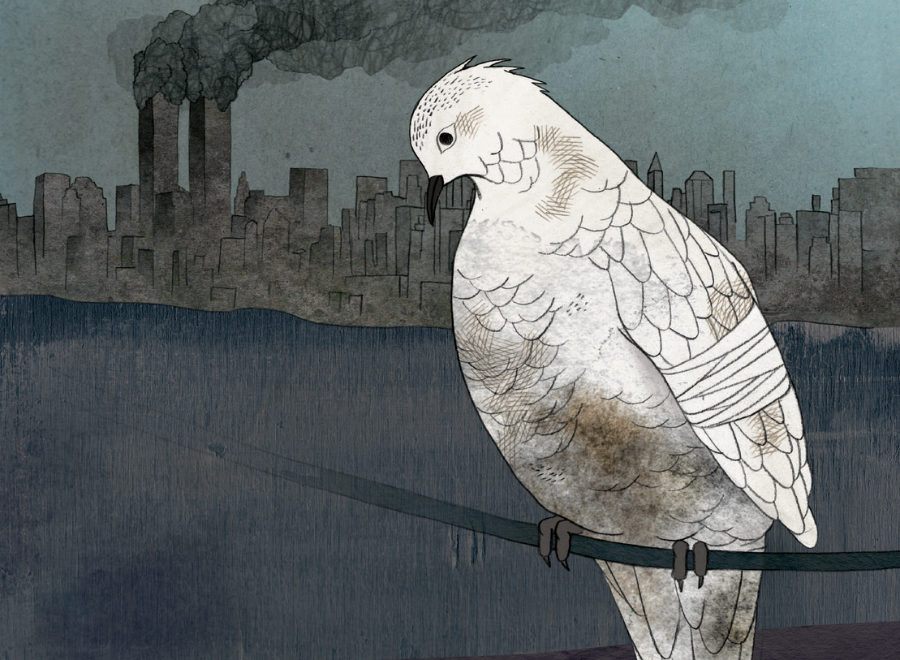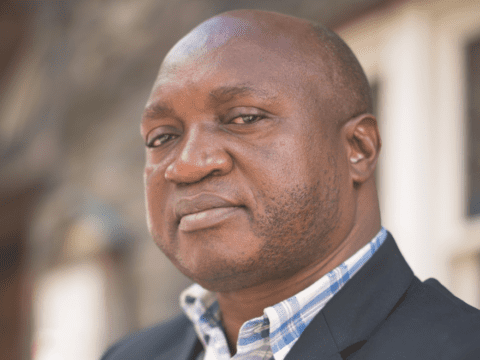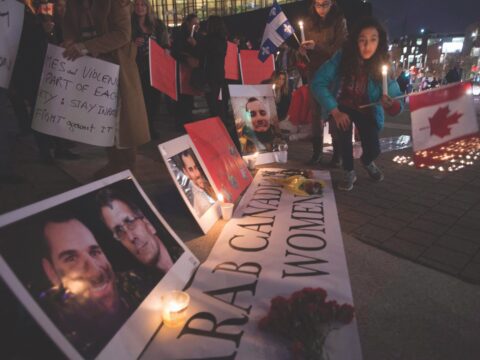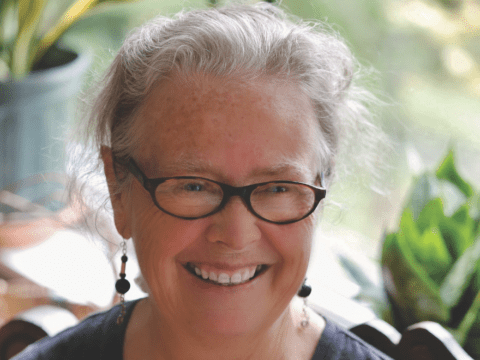Forever seared into the collective memory is the devastation left by four hijacked passenger planes 10 years ago this month: the twin towers of New York City’s World Trade Center barrelling to the ground, leaving thousands — dead and alive —enmeshed in its remains; the pillow of pitch blackness rising up from the Pentagon’s west wing in Washington, D.C.; and the debris of Flight 93 strewn across a field in Shanksville, Pa.
Nine-eleven “came as a deep shock to those who have dedicated their lives to peace,” non-violence activist Michael Nagler wrote in his paper Hope or Terror? Gandhi and the Other 9/11. “Whether or not we lost a loved one in that explosion of hatred (as I did), violence challenges our faith and adds an extra dimension of grief for those who feel most poignantly the futility of violence.”
The attacks of Sept. 11, 2001, by al-Qaeda resulted in nearly 3,000 deaths and a profound sense of insecurity. Emerging from 9/11’s fissures today are three disparate visions of how to bring about peace. The first, led by the United States, is the pre-emptive “war on terror” in places deemed to be the seedbeds of international terrorism. The second advocates a total commitment to pacifism in order to break the cycle of war, while a third position argues that pre-emptive strikes are too aggressive but that pacifism, too, is an impractical doctrine in today’s world. Failure to resolve bloody conflicts in places like Sudan and Rwanda is just as inhumane, these critics say; staging a military intervention in order to protect vulnerable people caught in war is the greater moral and ethical imperative. With global conflicts putting millions of lives at risk, it’s essential that people of faith and Canadians in general carefully consider these competing visions of peace. The 10-year anniversary of 9/11 is the perfect opportunity to reflect.
During the 1930s, pacifism was a formidable movement in Canada, and the Fellowship for a Christian Social Order, which included clergy and lay members of the newly founded United Church of Canada, was a strong objector to war. The ideal of non-violence had captured the group’s moral imagination after humanity’s capacity for destruction reached unprecedented levels during the First World War. When the Second World War broke out, many within the United Church struggled with Canada’s involvement. Nevertheless, while some clergy and laity remained pacifist or became conscientious objectors, most supported the war effort.
The church has never been a consistent proponent of non-violence when Canada goes to war, according to Very Rev. Bruce McLeod, now 81. “When you become a large [denomination] like the United Church, you far too easily become victims of the culture, losing the ability to stand over and against the status quo,” the former moderator says. “I’m not a doctrinaire pacifist, but I’m enough of one that I have never volunteered for military service.” He hopes there would be some level “of sophistication or skepticism on the part of citizenry as leaders wave their flags, blow their trumpets and summon them to the latest killing field.”
In 2008, responding to the “massive cruelty” of systematic killing and rape in African nations, the United Church endorsed a policy of “responsibility to protect.” It followed the World Council of Churches’ adoption of a similar position in 2006 — a growing international norm that looks beyond state sovereignty to the international community’s obligation to safeguard civilians caught in conflict.
Rev. Peter Denton is a United Church minister who teaches history at the Royal Military College in Kingston, Ont. In the book Believers in the Battlespace, Denton and his co-authors argue that military intervention creates more problems than it solves. “To make armed intervention the preferred tool for expressing international concern in the 21st century is to render ourselves clumsy and destructive — the well-intentioned bull in a china shop whose best option before very long is to get out before more damage is done.”
After nearly a decade of war in Afghanistan, Canada officially ended its combat mission in July, withdrawing almost 3,000 troops. Very Rev. Peter Short has shaken the oil- and grit-stained hands of Canadian soldiers — as well as those of Afghan army officials and civilians — as a member of the Interfaith Committee on Canadian Military Chaplaincy. “History will tell whether Afghans are better or worse off because of our involvement,” the former moderator admits. “At the same time, I think that Canada’s willingness to act and to sacrifice through the medium of the United Nations is a stride in the right direction. The world is small now and nations are intimate with one another in unprecedented ways. We cannot be indifferent or isolationist.”
In human terms, the American-led war on terror has resulted in 365,000 people being wounded and 7.8 million displaced in Afghanistan, Pakistan and Iraq, according to a study by Brown University’s Watson Institute for International Studies. An estimated 225,000 people have been killed — including 125,000 civilians in Iraq — and many more have died from the loss of access to health care, nutrition and clean drinking water.
In November 2005, Canadian James Loney and three other peace activists were taken hostage in Baghdad. Loney was in Iraq as a member of the Christian Peacemaker Teams, an organization that practices non-violent intervention in conflict zones. In exchange for freeing the hostages, the captors demanded that the United States release everyone it had detained in its occupation of Iraq. As a warning to the U.S. government, they murdered one of the activists, American Tom Fox, dumping his body in a Baghdad street.
Loney and the remaining hostages were rescued in early 2006 by British and American special forces. In his book, Captivity, Loney acknowledges the paradox of his liberation by a “phalanx of soldiers” — one of whom asked him to think long and hard about his peacemaking activities and the many people who risked their lives to save him.
Today, however, he is able to reconcile his rescue with his peace activism. “Simply put, we wouldn’t have been kidnapped if the U.S. and Britain hadn’t bombed, invaded and occupied Iraq, setting in motion the insurgency,” Loney says. “The institution that saved us created the very circumstances that required our intervention….Our captors lost family members, they were full of hate and rage, and they took up the gun to end the occupation of their country They merely kidnapped us to get money to buy those guns.”
Loney often talks about “breaking from the mad spiral of retribution — the eye-for-an-eye, bullet-for-a- stone and bomb-for-a-bullet” mentality. “There is this blind faith in the efficacy of violence,” he says. “But human freedom truly begins when we live in accordance with this purpose: giving life, and not taking it.”
But others — even committed peace activists — point out that the refusal to intervene in conflicts produces more victims. Ernie Regehr is the co-founder and former senior policy adviser to Project Ploughshares, an ecumenical agency of the Canadian Council of Churches based in Waterloo, Ont., that promotes conflict resolution through non-violence and opposes arms transfers to the developing world. In the spring of 2003, Regehr travelled to southern Sudan as part of a small international assessment team. Earlier that year, a guerrilla conflict had engulfed the Darfur region of Sudan. Rebel groups took up arms en masse, accusing the government of oppressing non-Arab Sudanese. According to the United Nations, the Darfur conflict affected more than five million people, with several hundred thousand dead from direct combat, starvation or disease.
Inside one encampment, Regehr met internally displaced people who had fled their burned homes and bombed-out villages in the Western Upper Nile. The southern Sudanese saw themselves as “abandoned and victims of inaction,” he says. “Saying to them, ‘We’re not going to help you on the basis of [pacifist] principle and personal views’ was very difficult for the Sudanese people to understand. They would look at you and say, ‘Whether you participate in the Sudanese government’s bombing mission against us or stand by and do nothing, whether your inaction is the product of indifference or of a principled commitment against military intervention, it’s all the same thing to us.’”
So, too, was the international community derelict when it refused military assistance to UN peacekeepers during the Rwanda genocide, according to Regehr. Over the course of 100 days in 1994, Hutu hard-liners slaughtered an estimated one-million minority Tutsis and moderate Hutus.
Says Regehr, “In the days of the bow and arrow and the single-shot rifle, the dangers of escalating violence were very low. But in most modern wars, in which state- of-the-art precision-guided munitions are used, civilian and military casualties are much higher. As such, the aim of pacifism can’t be to isolate ourselves from the direct commitment of violence. We have to be committed to building the kind of societies in which the overall level of violence is reduced and is controlled over time.”
Since 1987, Project Ploughshares has tracked armed conflicts in the world. At least 64 wars have ended during the past 23 years, it says. In a minority of cases, governments defeated insurgents, or rebels prevailed and had their demands met. In a third of conflicts, fighting essentially dissolved. Half ended through negotiated settlements.
Last March, NATO forces, led by a Canadian general, enforced a no-fly zone over Libya. The International Criminal Court later demanded the arrest of Libyan leader Moammar Gadhafi for the killing, injuries and imprisonment of hundreds of civilians during the recent uprising in the country. Canada has defended as well as participated in NATO’s Libya mission, although the intervention — like that in Afghanistan — has been criticized as modern imperialism disguised as humanitarianism.
Conscience Canada, an organization that opposes the use of income tax dollars for military purposes, takes issue with Canada’s involvement in the region. “Today, supporting the troops morally and economically has pulled Canadian society toward a more militaristic frame of mind,” says Donald Woodside, a Quaker and the past-president of Conscience Canada. “Society seems to be much more willing to take the risk of annihilation and destruction through war than to take the risk of non-violence.”
Although this month marks the 10th anniversary of the Sept. 11 attacks, peace builders around the world remember Sept. 11 — 1906 — as the birth of Mahatma Gandhi’s satyagraha or “soul force.”
“By strange coincidence, on Sept. 11, a date that now lives in infamy, Gandhi launched a new way of waging conflict that many believe can lead humanity from the mire of hatred,” says Michael Nagler, the author of Is There No Other Way? and president of the Metta Center for Nonviolence in Berkeley, Calif., which commemorates satyagraha annually.
To be sure, the 21st-century world is in a round-the-clock state of conflict. But Nagler says that “conflict is a natural part of life, and we need to find creative ways of dealing with it instead of wishing it will somehow go away.” He cites the gradual collapse of communist states in the early 1990s as examples, as well as the Arab spring, the Tunisian and Egyptian uprisings, which for the most part led to a peaceful transfer of power earlier this year. In his paper Hope or Terror?, Nagler writes, “Whether we’re aware of it or not, [St. Augustine] said, our deepest desire is ‘to seek fellowship and as far as we possibly can, peace with every man’ and woman — and all that lives. But those of us who work for peace are perhaps more aware of this desire and feel violations of it all the more deeply, for we not only long for but believe in peace — believe that it is possible even in our time.”
***
This story first appeared in The United Church Observer’s September 2011 issue with the title “Pacifism in a post-9/11 world.”















